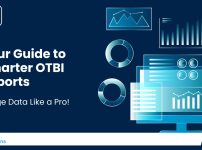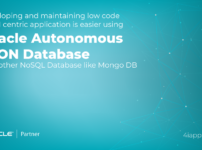Enhancing Business Efficiency with Boomi AI
Introduction
Boomi, a leading integration platform as a service (iPaaS), has extended its capabilities with artificial intelligence (AI) to streamline and automate integration processes. One of the most compelling features of Boomi AI is its ability to automatically generate process flows based on user-defined use cases or requirements, significantly reducing the time and effort required in integration development.

Objective
This case study explores Boomi AI’s ability to generate process flows, focusing on how AI- driven automation can transform complex, manual workflow creation into an efficient, optimized process. It demonstrates how this capability can accelerate integration projects, reduce errors, and enhance productivity.
Overview of Boomi AI
Boomi AI is designed to assist users in creating sophisticated integration processes by using machine learning models and historical data. The AI-driven approach allows for automatic recommendations, insights, and optimizations during the design phase. With process flow generation, Boomi AI examines use cases or requirements and builds suggested workflows to streamline the integration process.
Key features of Boomi AI include:
- Automated Process Flow Generation: AI dynamically creates integration workflows by analyzing user-provided inputs or predefined templates.
- Error Reduction: By leveraging historical data and learned patterns, AI minimizes human errors in workflow design.
- Optimization Suggestions: The platform offers optimization opportunities, highlighting potential performance enhancements or simplifications in the integration.
- Real-time Modifications: Users can adjust the suggested process flow in real-time based on feedback or evolving requirements.
Use Case: Automatic Process Flow for E-Commerce Data Integration
Scenario:
An e-commerce business wants to automate its order fulfillment process by integrating its online store with its warehouse management system (WMS) and accounting platform. The business outlines the following requirements:
- Retrieve customer orders from the e-commerce platform daily.
- Send order details to the warehouse management system for processing.
- Push the invoicing data to the accounting platform.
- Notify the customer via email when the order is fulfilled.
Boomi AI’s Approach
1. Requirement Analysis
Boomi AI analyzes the use case and user inputs, focusing on the key requirements: order retrieval, warehouse integration, invoicing, and notifications.
2. Process Flow Generation
Based on these requirements, Boomi AI automatically generates an initial process flow: Retrieve Orders: A connector to the e-commerce platform is established to pull daily order data.
Warehouse Integration: The order data is automatically routed to the warehouse management system, including transformations where necessary.
Invoicing: Boomi AI configures a flow that pushes the order data to the accounting system, triggering invoicing workflows.
Notification: After fulfillment, Boomi AI creates a flow for automated customer notification via email, with real-time updates.
Use case 1: Generate a flow that processes eCommerce orders from Shopify, updates the inventory in the ERP, and sends tracking numbers to the customer via email
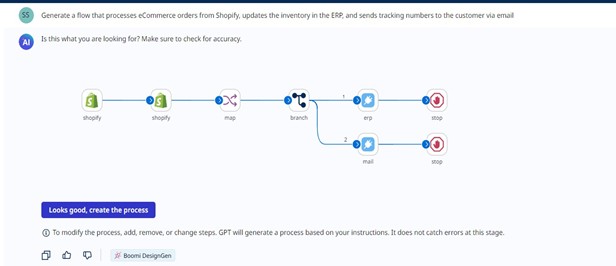
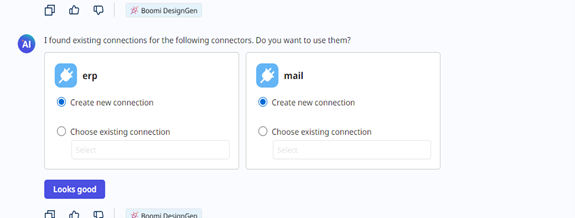

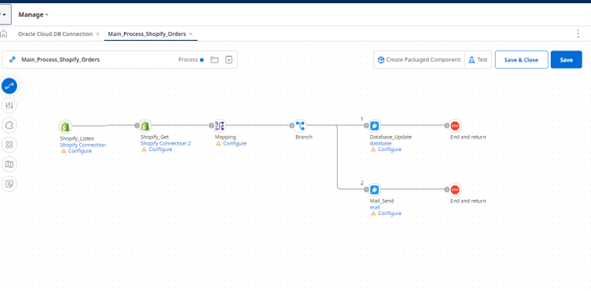
Use case-2: create a process ‘PRCS_New_Residence_AI_GENERATED’ with start shape as no data and pass a the service id from the message shape, using the service id, fetch the data from salesforce get action, and use the data which it retrieved from salesforce and create a Json request and trigger the http rest API to create new residence, get the http rest API response and update it back into salesforce table using the service id as a filter
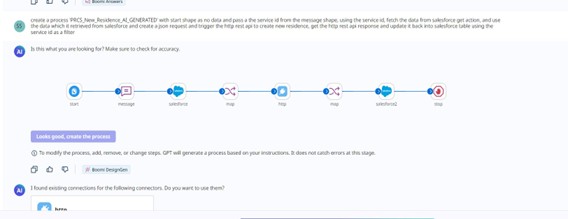

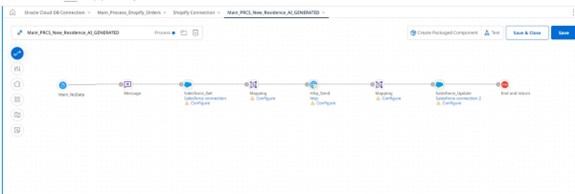
3. AI-Driven Optimizations
Boomi AI reviews the process and suggests optimization for error handling during data transfers, with fallback actions in case of failures.
AI-Generated Workflow Representation
Boomi AI would generate the process flow for this use case as follows:
- Start: Schedule trigger for daily order retrieval.
- Retrieve Orders: API or connector fetches orders from the e-commerce platform.
- Transform Data: AI suggests any necessary transformations for order data.
- Warehouse Processing: Send orders to the warehouse management system.
- Generate Invoice: Post order data to the accounting system for invoicing.
- Notification: AI configures an email connector to notify the customer of order fulfillment.
- Error Handling: AI automatically inserts error handling to log failures and retry as needed.
- End: Complete the process with real-time monitoring and audit logging.
Key Benefits
1. Speed of Delivery
Boomi AI dramatically reduces the time required to design and implement integration processes. What traditionally could take weeks to develop can now be done in hours.
2. Accuracy and Optimization
AI reduces the risk of errors in complex process flows by automatically applying best practices and offering intelligent recommendations based on data-driven insights.
3. Flexibility and Scalability
Users can modify or scale the AI-generated process flows as business needs evolve. Boomi AI also offers suggestions to adapt to changing environments or requirements.
4. Lower Costs
By automating significant portions of the process flow design, businesses can cut down on development and maintenance costs while improving efficiency.
Conclusion
Boomi AI’s capability to provide automatic process flows based on use cases or requirements offers organizations a powerful tool to streamline their integration projects. With AI handling much of the workflow generation, businesses can focus on strategic activities, saving time and resources. This automated process flow generation not only accelerates delivery but also ensures that workflows are optimized, scalable, and future- proof. Boomi AI continues to drive innovation in the integration space, offering a practical solution to the challenges of modern-day digital transformation.
About the Author
Hafil S is an experienced SOA consultant with expertise in designing and implementing integration solutions. He specializes in leveraging cutting-edge technologies to optimize business processes and drive digital transformation.


